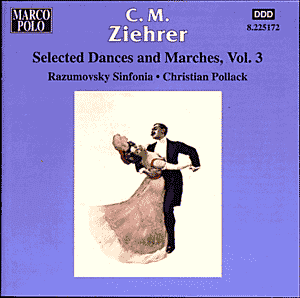Carl Michael ZIEHRER (1843-1922)
Selected Dances & Marches Vol. 3
Schönfeld March (Freiherr von Schönfeld-Marsch), Op.422 (1920)
On the High seas Waltz (Auf hoher See, Walzer), Op. 66 (1866)
Cavalry French Polka (Cavallerie, Polka française), Op.454 (1893)
A Glance at Her! Quick Polka (Ein Blick nach Ihr), Op.55 (1866)
Mountain Children Waltz (Gebirgskinder Waltzer), Op. 444 (1892)
Into the Twentieth Century March (Auf! In's XX, Jahrhunert Marsch), Op. 501 (1899)
D'Kernmad'In, Styrian Dance (D'Kernmad', Stelerische Tänze), Op. 58 (1866)
Ball-fever French Polka (Ballfieber Polka française), Op. 406 (1899)
I laugh, Waltz (Ich lach'l, Walzer), Op. 554 (1898/1914)
If one has Money (Wenn man Geld hat, Marsch), Op.539 (1908)
Oh, these Hussars! Waltz (O, diese Husaren! Walzer) Op. 552 (1912)
Throwing Bouquets Polka Mazurka (Wurf-Bouquet, polka mazurka), Op. 426 (1890)
Ziehrerish Waltz (Ziehrereien Walzer), Op. 478 (1897)
Razumovsky Sinfonia, Christian Pollack
Rec. Slovak Radio Concert Hall, Bratislava; June 2000
MARCO POLO 8.225172 [75.55]
Crotchet AmazonUK AmazonUS Amazon recommendations

Little is now heard or mentioned about this prolific composer of operettas and hundreds of Austrian dances who came to fame at the turn of the Century. Carl Ziehrer's style of composition is close to that of Strauss and Lumbye and he was in fact one of the greatest rivals to the Strauss brothers for writing popular dance music in Vienna. His background as a bandmaster shows in some of his pieces. They are characterised by a militarily brash style and often contain elements of folk music that are refreshingly different. Perhaps the pieces that most resemble Straussian Vienna are his polkas, which recognisable chords in the string sections. Likewise, some of Ziehrer's marches (the Schönfeld March in particular) could have come from the pen of Sousa, who lived during the same period.
Ziehrer's waltzes are rather haunting and at times flow with the flamboyant style of a ballet score. Of those that are particularly charming, the Mountain Children and On the High Seas are examples that seem to have unusually rich scoring for ballroom consumption.
Many of Ziehrer's waltzes come from his operettas: the I laugh, waltz comes from his successful operetta Das dumme Herz (The Stupid Heart, 1914) a production which embodied much of his previously arranged dance music.
Perhaps the strong beat necessary in dance pieces is too often overstated, and this tends to bring a repetitive monotony to 75 minutes of listening of the dances. This stated one has to admit that J. Strauss lovers will enjoy the gaiety of the music.
A disappointingly crude effect, more in keeping in 'Tin Pan Alley', comes from the dull thud of bass drum with cymbal combination in A glance at her. The acoustics are ideally suited to the ambience of a ballroom with the strings forward focused and the brass nicely softened. Certainly, the recording allows one to mentally visualise a Viennese scene in the 1890s.
The Razumovsky Sinfonia draws its musicians from Slovak Radio, Slovak Chamber and Opera Theatre orchestras and is an ensemble formed for Naxos/Marco Polo contracts.
Christian Pollack is an Austrian conductor who was appropriately born in Vienna. His activities include musicological research in the field of Viennese dance music and the works of the Strauss family.
Notes are more than adequate and cover much factual detail. They are written in English, French and German.
Raymond Walker